
Broward County is a county in Florida, United States, located in the Miami metropolitan area. It is Florida's second-most populous county after Miami-Dade County and the 17th-most populous in the United States, with 1,944,375 residents as of the 2020 census. Its county seat and most populous city is Fort Lauderdale, which had a population of 182,760 as of 2020. The county is part of the South Florida region of the state.

Hampton is a city in Bradford County, Florida, United States. It is located in North Florida. The population was 432 at the 2020 census.

Fort Lauderdale is a coastal city located in the U.S. state of Florida, 30 miles (48 km) north of Miami along the Atlantic Ocean. It is the county seat of and most populous city in Broward County with a population of 182,760 at the 2020 census, making it the tenth-most populous city in Florida. After Miami and Hialeah, Fort Lauderdale is the third-most populous city in the Miami metropolitan area, which had a population of 6,166,488 in 2019.
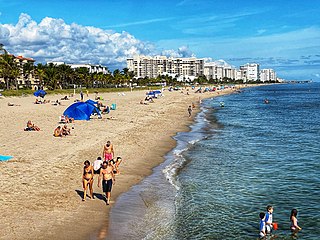
Lauderdale-by-the-Sea is a town in Broward County, Florida, United States, situated 33 miles north of Miami. The town is part of the South Florida metropolitan area. As of the 2020 census, the population was 6,198.

Sea Ranch Lakes is a village in Broward County, Florida, United States. The village is part of the Miami metropolitan area of South Florida. It is located on North Ocean Drive and is surrounded by Lauderdale-by-the-Sea. The majority of the village is a gated community, with the remainder being a public shopping plaza and a private beach club for village residents, with a pool and access to Sea Ranch Lakes Beach. The population was 540 at the 2020 census.

Patton Village is a city in Montgomery County, Texas, United States. The population was 1,647 at the 2020 census. It is located in Greater Houston.
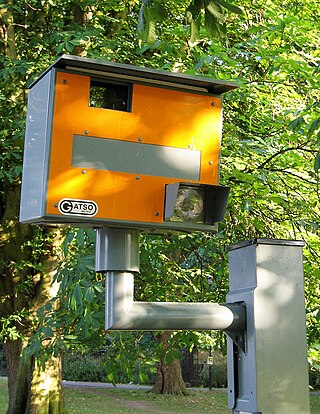
A traffic enforcement camera is a camera which may be mounted beside or over a road or installed in an enforcement vehicle to detect motoring offenses, including speeding, vehicles going through a red traffic light, vehicles going through a toll booth without paying, unauthorized use of a bus lane, or for recording vehicles inside a congestion charge area. It may be linked to an automated ticketing system.

Fort Lauderdale–Hollywood International Airport – also known as Fort Lauderdale Airport and historically as Merle Fogg Field and Broward County International Airport – is a major public airport located in Broward County, Florida, United States, roughly 3 miles (4.8 km) southwest of downtown Fort Lauderdale and 21 miles (34 km) north of Miami. The second busiest of the Miami metropolitan area's commercial airports, it is located off Interstate 595, Interstate 95, U.S. Route 1, Florida State Road A1A, and Florida State Road 5, and is bounded by the cities of Fort Lauderdale, Hollywood, and Dania Beach.
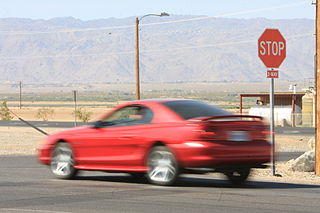
A moving violation or traffic violation is any violation of the law committed by the driver of a vehicle while it is in motion. The term "moving" distinguishes it from other motor vehicle violations, such as paperwork violations, parking violations, or equipment violations. The United States Department of State makes reference to moving violations in its enforcement guidance.

Interstate 595 (I-595), also known as the Port Everglades Expressway and unsigned FloridaState Road 862, is a 12.86-mile (20.70 km) auxiliary Interstate Highway that connects I-75 and Alligator Alley in the west with Florida's Turnpike, I-95, Fort Lauderdale–Hollywood International Airport, U.S. Highway 1, and SR A1A before terminating at Port Everglades in the east. The Interstate route was conceived in 1969 and planned as an Interstate starting in 1974. Construction began in 1984, with the expressway opening in stages in the late 1980s, and it was completed in 1991. The reversible tolled express lanes opened in 2014.
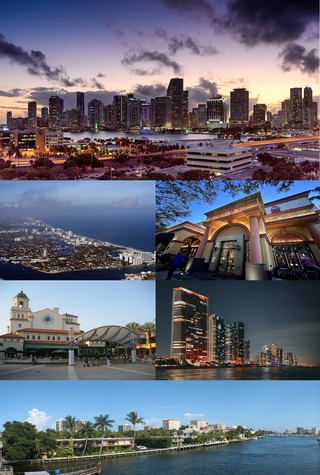
The Miami metropolitan area is a coastal metropolitan area in southeastern Florida. It is the ninth-largest metropolitan statistical area (MSA) in the United States, the fifth-largest metropolitan area in the Southern United States, and the largest metropolitan area in Florida. It is also known as South Florida, SoFlo, SoFla, the Gold Coast, Southeast Florida, the Tri-County Area, or Greater Miami, and officially as the Miami–Fort Lauderdale–West Palm Beach Metropolitan Statistical Area. With a population of 6.18 million, its population exceeds 31 of the nation's 50 states as of 2023. It comprises the three most populated counties in the state, Miami-Dade County, Broward County, and Palm Beach County, which rank as the first, second, and third-most populous counties in the state, respectively. Miami-Dade County, with 2,701,767 people in 2020, is the seventh-most populous county in the United States.

Andytown was a town located in Broward County, Florida, United States at the intersection of U.S. 27 and I-75. It was demolished in 1979 in order to allow for the expansion of the Alligator Alley portion of Interstate 75. Andytown can be found on maps from the 1970s, aerial maps of Florida. It remains today on some online map services. MSN's Maps service, for instance, returns a map for a search of Andytown. Google Maps similarly includes a place marker for it. Andytown was at the intersection of US 27 and State Road 84.
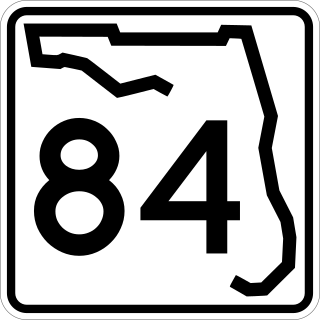
State Road 84 is a highway in the U.S. state of Florida originally extending from Tamiami Trail in Naples to U.S. Route 1 in Fort Lauderdale. The road consists of two noncontiguous pieces––in Collier County as Davis Boulevard and in Broward County as Marina Mile Boulevard and highway frontage roads.

Florida State Road 817 (SR 817) is a 25.691-mile-long (41.346 km) state highway in the U.S. state of Florida, locally known as Northwest 27th Avenue in Miami-Dade County and University Drive in Broward County. Its southern terminus is an intersection in Opa-locka with SR 9, which continues south along Northwest 27th Avenue to Dixie Highway in the Coconut Grove neighborhood of Miami. Its northern terminus is at State Road 834 in Coral Springs, though the right of way continues north to Loxahatchee Road at the Palm Beach County line.

In the United States, speed limits are set by each state or territory. States have also allowed counties and municipalities to enact typically lower limits. Highway speed limits can range from an urban low of 25 mph (40 km/h) to a rural high of 85 mph (137 km/h). Speed limits are typically posted in increments of five miles per hour (8 km/h). Some states have lower limits for trucks, some also have night and/or minimum speed limits.

Broward Boulevard is an 11.766 miles (18.936 km) long major east–west thoroughfare through Broward County, Florida, mostly designated State Road 842 (SR 842). The western terminus is an intersection with Commodore Drive in Plantation, and it continues east to U.S. Route 1 (US 1) in Fort Lauderdale. The westernmost 5.4 miles (8.7 km) is designated as County Road 842, and is seldom signed as such.
Transportation in Florida includes a variety of options, including Interstate Highways, U.S. Highways, and Florida State Roads; Amtrak and commuter rail services; airports, public transportation, and sea ports, in a number of the state's counties and regions.

The New River is a tidal estuary in South Florida, United States. Despite its name, it is not a true natural river, but a channel composed of many tributary canals. The channel is connected to the Everglades through a series of man-made canals. After passing through Fort Lauderdale, the channel connects to the Intracoastal Waterway and Atlantic Ocean at Port Everglades cut. The channel is entirely within Broward County and is composed from the junction of three main canals which originate in the Everglades, splitting off from the Miami Canal. They are the North New River Canal, which flows south from Lake Okeechobee along the east side of U.S. 27 and then east along the north side of State Road 84 / Interstate 595; the South New River Canal, which flows east from the Miami Canal along the north side of Griffin Road and the south side of Orange Drive; and a canal which flows east along the south side of Sunrise Boulevard. The Henry E. Kinney Tunnel in downtown Fort Lauderdale travels underneath the New River.

Speed limits are enforced on most public roadways by authorities, with the purpose to improve driver compliance with speed limits. Methods used include roadside speed traps set up and operated by the police and automated roadside 'speed camera' systems, which may incorporate the use of an automatic number plate recognition system. Traditionally, police officers used stopwatches to measure the time taken for a vehicle to cover a known distance. More recently, radar guns and automated in-vehicle systems have come into use.
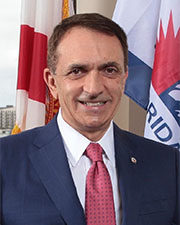
Dean J. Trantalis is an American politician and mayor of Fort Lauderdale, Florida. Before his election as mayor, Trantalis served as a city commissioner for Fort Lauderdale from 2009 to 2017.



















